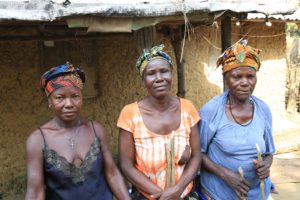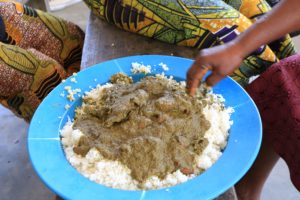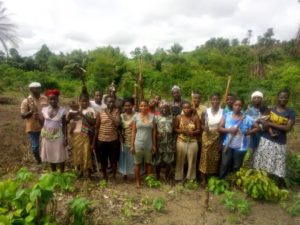Digging into the farming techniques in Tikonko, Sierra Leone. What’s required? Many hands, traditional farming ingenuity, and minimal equipment.

As part of our Sustainable Food and Agriculture Program, RHCI proudly supports 3 farmer based organizations, which are led mostly by women, by providing costs of locally sourced seeds and land. This support increases the community-wide food sourcing, especially during the hunger season when there are unpredictable rains and droughts. Crops produced include cassava, groundnut, and okra.
What is Cassava? Cassava is a starchy root vegetable, much like a potato, used in savory dishes by mixing it with spices to make stew or preparing it over rice.

Cassava over rice
Cassava is packed with starchy calories and carbohydrates, making it a filling meal. The leaves are prepared much like spinach and are packed with vitamins.
What is Groundnut? Groundnuts are essentially peanuts, which RHCI uses for meals in our malnutrition program. It is mixed with dried fish powder, and served to malnourished children because of its high levels of protein. Dishes also include the infamous groundnut stew, or can be mashed into peanut butter.
What is Okra? Okra is a green seed pod vegetable, packed with fiber and water. Typically Okra is prepared sautéed, fried, or mixed in a stew with cassava or groundnuts.
A Further look at Cassava
Because the crop is drought tolerant, cassava is a cash crop with a high yield in Sierra Leone. But perhaps the most interesting factor of the cassava crop is the traditional farming techniques used by these supported farm based organizations to produce.
To begin the production, the land must be cleared. With machetes in hand, the farmers chop away the previously harvested plants. Once the land is dried, fires are set to burn the debris and existing plans, a process known as a “prescribed burn”, because it improves the health of the fields.
Now, it’s time to replace the the hands of machetes with hoes. The hoes are used to soften the soil and dig holes for the crops. Bare in mind, these hoes are typically handmade with sticks found in the forest and a sharp metal blade attached.
During the digging process, additional farmers prepare the previously grown cassava for planting. With the machete back in hand, cassava planting requires using the existing cassava tubes to be chopped by the stems for replanting.
These stems are then placed at an angle in each hole, a labor intensive and back bearing process, then covered with soil. With a small budget, fertilizer is not typically used.
Watering is done by hand, using buckets to pour over each crop, usually the duty of children. A mission that requires many hands and many hours of labor in the heat. After 8 months, the cassava leaves are collected by hand. The full cassava crop however, takes 18 months to harvest. The cassava is hand-pulled and separated from its roots. Yet another back bearing experience.
The Reality of Farming in Sierra Leone
Like any farming done around the world, there is a high risk for unpredictable rain or drought at unexpected times. “The hunger season lasts several months. At times during the summer, it rains like crazy, and none of the harvest is matured. We’ve experienced bad timing before. And in Sierra Leone, when there is drought, there is no plan B. There is no option for a loan for the next harvest. I have done the labor myself while I lived in Tikonko and had a garden. Grinding with a heavy pole…it’s exhausting. Now imagine doing it while sick with malaria” (Dr. Gary Johnson, Board Member).
Harvesting Hope
As supporters of these Farmer Based Organization, RHCI provides seeds at a modest cost and has donated land for harvesting. The operations are entirely run by the local community members and responsibility of labor relies on them. To prevent food shortage during this hunger season, when there is unpredictable weather, RHCI has collaborated with locally sourced distributers to create reusable plastic storage bags for storage. These bags are impervious to odor and durable to outlast rats and mice. These storage bags increase the storage life by 3 times in comparison to the traditionally used rice bags.

In collaboration with local farmers, RHCI continues to respect the traditional farming techniques used, and admire the ambitious labor to produce food for the Tikonko community. Together, we can end hunger and malnutrition.

Wow!! A very wonderful website. Keep it up RHCI.